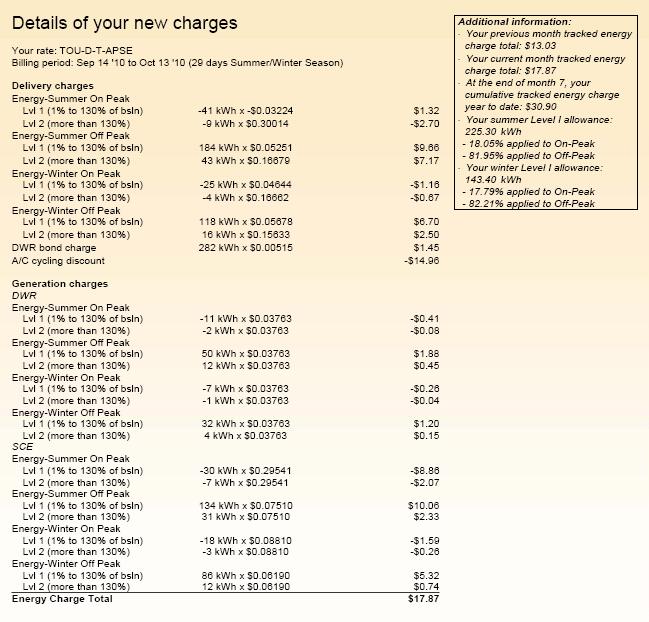Boomer23
Well-known member
I was really happy to learn some new info from the SCE reps at the LA Auto Show today.
We've been wondering and debating about how SCE calculates when to bump us from Tier 1 to Tier 2 on a Time of Use rate plan. Well I finally understand it. I'll use the TOU-D-TEV rate plan to illustrate.
Basically, your Tier 1 allowance is calculated monthly, not hourly or daily.
To calculate your monthly Tier 1 allowance,
1. get your baseline daily allowance from SCE's web site http://www.sce.com/CustomerService/billing/tiered-rates/baseline-chart-map.htm
2. Use this list of communities to get your baseline region. http://www.sce.com/NR/sc3/tm2/pdf/ce62-12.pdf
3. I'm in Region 6, so my Summer baseline allocation is 9.2 kWh, Winter baseline is 9.6 kWh.
4. Calculate your monthly Tier 1 allocation by multiplying by 1.3 to get 130% of baseline, then by 30 for a 30 day month.
5. 9.2 kWh X 1.3 X 30 = 358.8 kWh/month.
6. Now, in any Summer month, any power usage above 358.8 kWh for a month bumps me into Tier 2 of any of the three rate time periods. Winter would be 374.4 kWh. There are only two Tiers.
I have solar power that generates more than I use, and in the past four years, there has only been one month, a December, when I used slightly more than my 374 kWh Tier 1 allowance. So I would almost never have entered Tier 2 pricing on the TOU-D-TEV rate schedule.
If I drive my LEAF 9,000 miles per year and I get 3 miles/kWh NET from the wall plug, I'd need to charge 3,000 kWh/year, or 250 kWh/month. If I look at the year 2009 and add 250 kWh to each month's net usage that the SCE meter would see, I'd have only entered Tier 2 in December of that year.
So I'll almost always be in Tier 1, even with 3,000 kWh of charging per year. The best TOU rate is 10 cents per kWh during the Super Off Peak midnight to 6 am period. And looking back at 2010, there were five months when I'd still have had a net generation in excess of usage.
By the way, this is BETTER than if I had the dual meter TOU-EV-1 plan, which has a best rate of 11 cents per kWh.
We've been wondering and debating about how SCE calculates when to bump us from Tier 1 to Tier 2 on a Time of Use rate plan. Well I finally understand it. I'll use the TOU-D-TEV rate plan to illustrate.
Basically, your Tier 1 allowance is calculated monthly, not hourly or daily.
To calculate your monthly Tier 1 allowance,
1. get your baseline daily allowance from SCE's web site http://www.sce.com/CustomerService/billing/tiered-rates/baseline-chart-map.htm
2. Use this list of communities to get your baseline region. http://www.sce.com/NR/sc3/tm2/pdf/ce62-12.pdf
3. I'm in Region 6, so my Summer baseline allocation is 9.2 kWh, Winter baseline is 9.6 kWh.
4. Calculate your monthly Tier 1 allocation by multiplying by 1.3 to get 130% of baseline, then by 30 for a 30 day month.
5. 9.2 kWh X 1.3 X 30 = 358.8 kWh/month.
6. Now, in any Summer month, any power usage above 358.8 kWh for a month bumps me into Tier 2 of any of the three rate time periods. Winter would be 374.4 kWh. There are only two Tiers.
I have solar power that generates more than I use, and in the past four years, there has only been one month, a December, when I used slightly more than my 374 kWh Tier 1 allowance. So I would almost never have entered Tier 2 pricing on the TOU-D-TEV rate schedule.
If I drive my LEAF 9,000 miles per year and I get 3 miles/kWh NET from the wall plug, I'd need to charge 3,000 kWh/year, or 250 kWh/month. If I look at the year 2009 and add 250 kWh to each month's net usage that the SCE meter would see, I'd have only entered Tier 2 in December of that year.
So I'll almost always be in Tier 1, even with 3,000 kWh of charging per year. The best TOU rate is 10 cents per kWh during the Super Off Peak midnight to 6 am period. And looking back at 2010, there were five months when I'd still have had a net generation in excess of usage.
By the way, this is BETTER than if I had the dual meter TOU-EV-1 plan, which has a best rate of 11 cents per kWh.





